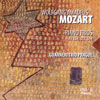Mozart Piano Trios K502 & K564; Divertimento K254
Balance problems mean the spotlight is thrown on an unsympathetic pianist
View record and artist detailsRecord and Artist Details
Composer or Director: Wolfgang Amadeus Mozart
Genre:
Chamber
Label: Praga Digitals
Magazine Review Date: 4/2007
Media Format: Super Audio CD
Media Runtime: 57
Mastering:
Stereo
DDD
Catalogue Number: PRDDSD250233

Tracks:
| Composition | Artist Credit |
|---|---|
| Keyboard Trio No. 3 |
Wolfgang Amadeus Mozart, Composer
Guarneri Trio Of Prague Wolfgang Amadeus Mozart, Composer |
| Keyboard Trio No. 6 |
Wolfgang Amadeus Mozart, Composer
Guarneri Trio Of Prague Wolfgang Amadeus Mozart, Composer |
| Divertimento |
Wolfgang Amadeus Mozart, Composer
Guarneri Trio Of Prague Wolfgang Amadeus Mozart, Composer |
Author: Nalen Anthoni
Pianist Ivan Klánsky dominates the group through his icy brilliance. Of course, Mozart did call these works piano trios; but the remaining musicians are meant to be in partnership and here the schematic balance is rather skewed. Klánsky’s playing is confined to pin-sharp notes and a polarised black-and-white tonality that illustrate angularities in the music. Other aspects are overlooked. The Larghetto of K502, for example, doesn’t quite recover from a stark exposé of the opening theme though the conciliatory contributions of violinist Cenek Pavlík and the reticently placed cellist Marek Jerie make some amends. Suspicion that Klánsky is one-sided in his view of Mozart is confirmed in the finale of K564. This rondo with episodes that are repeated gets short shrift because a lack of imagination impels him to be metronomic and to play each repeat the same way.
These performances are not enlightening. Fortunately Maria João Pires, Augustin Dumay and Jian Wang, evenly balanced, offer a finer option. Pires explores the capacity of the modern piano for a lateral singing line. Phrases swell and contract, and are malleably shaped; variety of touch combined with carefully controlled pedalling engenders mutations of dynamic colour; rhythm is flexible; paragraphs cohere. And all this is accomplished without distorting the style of the music. Her colleagues know their parts too and the end result is interpretation on the highest level. Sadly, Pires and Dumay appear to have dropped out of the recording scene. But they have left a distinguished legacy.
These performances are not enlightening. Fortunately Maria João Pires, Augustin Dumay and Jian Wang, evenly balanced, offer a finer option. Pires explores the capacity of the modern piano for a lateral singing line. Phrases swell and contract, and are malleably shaped; variety of touch combined with carefully controlled pedalling engenders mutations of dynamic colour; rhythm is flexible; paragraphs cohere. And all this is accomplished without distorting the style of the music. Her colleagues know their parts too and the end result is interpretation on the highest level. Sadly, Pires and Dumay appear to have dropped out of the recording scene. But they have left a distinguished legacy.
Discover the world's largest classical music catalogue with Presto Music.

Gramophone Digital Club
- Digital Edition
- Digital Archive
- Reviews Database
- Full website access
From £8.75 / month
Subscribe
Gramophone Full Club
- Print Edition
- Digital Edition
- Digital Archive
- Reviews Database
- Full website access
From £11.00 / month
Subscribe
If you are a library, university or other organisation that would be interested in an institutional subscription to Gramophone please click here for further information.




